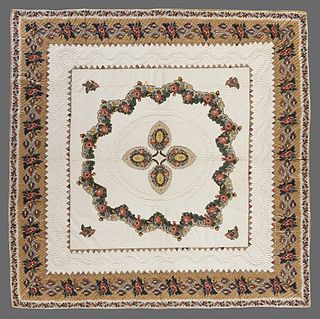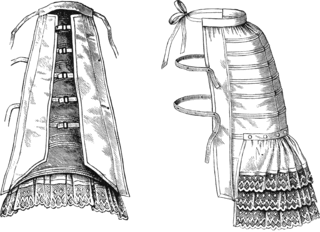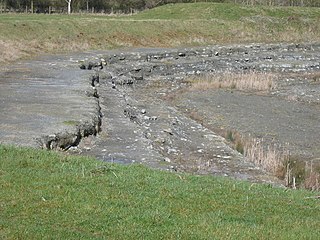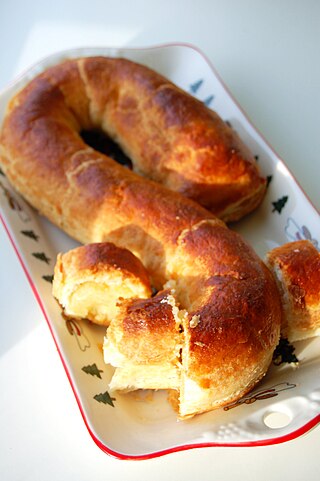
A lever is a simple machine consisting of a beam or rigid rod pivoted at a fixed hinge, or fulcrum. A lever is a rigid body capable of rotating on a point on itself. On the basis of the locations of fulcrum, load and effort, the lever is divided into three types. It is one of the six simple machines identified by Renaissance scientists. A lever amplifies an input force to provide a greater output force, which is said to provide leverage, which is mechanical advantage gained in the system, equal to the ratio of the output force to the input force. As such, the lever is a mechanical advantage device, trading off force against movement.

Chalk is a soft, white, porous, sedimentary carbonate rock. It is a form of limestone composed of the mineral calcite and originally formed deep under the sea by the compression of microscopic plankton that had settled to the sea floor. Chalk is common throughout Western Europe, where deposits underlie parts of France, and steep cliffs are often seen where they meet the sea in places such as the Dover cliffs on the Kent coast of the English Channel.

Ohm's law states that the electric current through a conductor between two points is directly proportional to the voltage across the two points. Introducing the constant of proportionality, the resistance, one arrives at the three mathematical equations used to describe this relationship:

A lathe is a machine tool that rotates a workpiece about an axis of rotation to perform various operations such as cutting, sanding, knurling, drilling, deformation, facing, threading and turning, with tools that are applied to the workpiece to create an object with symmetry about that axis.

Broderie perse is a style of appliqué which uses printed motifs from one fabric to create a design on a background fabric. It was popular in the late 18th century and early 19th centuries. The technique could be considered an early form of puzzle piecing.

Lontra is a genus of otters from the Americas.

A bone bed is any geological stratum or deposit that contains bones of whatever kind. Inevitably, such deposits are sedimentary in nature. Not a formal term, it tends to be used more to describe especially dense collections such as Lagerstätte. It is also applied to brecciated and stalagmitic deposits on the floor of caves, which frequently contain osseous remains.

Moulding, or molding, also coving, is a strip of material with various profiles used to cover transitions between surfaces or for decoration. It is traditionally made from solid milled wood or plaster, but may be of plastic or reformed wood. In classical architecture and sculpture, the moulding is often carved in marble or other stones. In historic architecture, and some expensive modern buildings, it may be formed in place with plaster.

The hypotrachelium is the upper part or groove in the shaft of a Doric column, beneath the trachelium. The Greek form is hypotrakhelion.

Dimity is a collective term for figured cloths of harness loom decorated with designs and patterns. It is a strong cotton cloth with various stripes and illustrations. Dimity is bleached or washed after looming, less often dyed—unlike fustian, which is usually dyed.
Banket is a town in the province of Mashonaland West, Zimbabwe. It is located about 95 km north-west of Harare on the main Harare-Chinhoyi road. According to the 1982 Population Census, the town had a population of 5,698. The name of the town is derived from banket rock formation: early settlers saw a conglomerate, which they hoped would bear gold, like the banket of the Witwatersrand gold fields. The conglomerate was not gold-bearing, although gold was late discovered and, along with chromite, is still mined in the area. Cattle, maize, cotton and tobacco are commercially farmed in the area.
Russell Blair Tiffin is a Zimbabwean cricket umpire and former cricketer. He was a member of the ICC International umpire panel from 1995 to 2018 when he retired.
Banket was a Slovak pop band active between 1984 and 1991. Its lead singer was Richard Müller. Banket were among the pioneers of electronic pop music in Slovakia and Czechoslovakia in the 1980s. In this regard, they can be considered Slovakia's answer to Depeche Mode.

Kidd Lake State Natural Area is a protected area of Illinois on 800 acres (324 ha) in Monroe County, Illinois, United States, adjacent to the Fults Hill Prairie State Natural Area.

Latzelia is an extinct genus of scutigeromorph centipedes, and the type and only genus of the family Latzeliidae. It existed during the Carboniferous in what is now Illinois. It was described by Samuel Hubbard Scudder in 1890, and the type species, and only known species, is Latzelia primordialis. The genus name honors Austrian zoologist Robert Latzel.

Akeman Street was a railway station at Woodham, Buckinghamshire, where the railway linking Ashendon Junction and Grendon Underwood Junction crossed the Akeman Street Roman road.

The Cornbrash Formation is a Middle Jurassic geological formation in England. It ranges in age from Bathonian to Callovian, the uppermost part of the Middle Jurassic. Dinosaur remains are among the fossils that have been recovered from the formation, although none have yet been referred to a specific genus. The name Cornbrash is an old English agricultural name applied in Wiltshire to a variety of loose rubble or brash which, in that part of the country, forms a good soil for growing corn. The name was adopted by William Smith for a thin band of shelly limestone which, in the south of England, breaks up in the manner indicated. Although only a thin group of rocks, it is remarkably persistent; it may be traced from Weymouth to the Yorkshire coast, but in north Lincolnshire it is very thin, and probably dies out in the neighborhood of the Humber. It appears again, however, as a thin bed in Gristhorpe Bay, Cayton Bay, Wheatcroft, Newton Dale and Langdale. In the inland exposures in Yorkshire it is difficult to follow on account of its thinness, and the fact that it passes up into dark shales in many places the so-called clays of the Cornbrash, with Avicula echinata. The Cornbrash is of little value for building or road-making, although it is used locally; in the south of England it is not oolitic, but in Yorkshire it is a rubbly, marly, frequently ironshot oolitic limestone. In Bedfordshire it has been termed the Bedford limestone.

In lithostratigraphy, coal measures are coal-bearing strata, with the term typically applied to European units of the Upper Carboniferous System.

The Dutch letter is a type of pastry that is typically prepared using a mixture of flour, eggs and butter or puff pastry as its base and filled with almond paste, dusted with sugar and shaped in an "S" or other letter shape. Marzipan, an almond paste prepared with almond meal and honey or sugar, is sometimes used as the filling. The Dutch letter has a porous or airy and flaky texture.

Banket (bahn-KET) is a type of sweet pastry filled with almond paste, which originated in the Netherlands. It is made in several forms, each of which go by various names. One variety consists of long bars or loaves which are sliced into individual servings – also referred to in English as almond rolls or almond patties, and in Dutch as banketstaven. Another variety are rolled logs shaped into letters – also referred to in English as Dutch letters, banket letters, almond letters, or butter letters; and in Dutch as banketletter or boterletter. It is sometimes made as individual banket or almond patties.
















